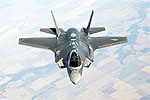Lockheed Martin, CAE Establish Canadian Training Alliance For The F-35 Lightning II
 PARIS, June 17, 2013 – On the first day of the 2013 Paris Air Show, a new alliance between Lockheed Martin [NYSE: LMT] and CAE [TSX and NYSE: CAE] was announced when officials from both companies signed a Memorandum of Understanding (MOU) for F-35 Lightning II training system support and services in Canada. CAE is a global leader in modeling, simulation and training for civil aviation and defence.
PARIS, June 17, 2013 – On the first day of the 2013 Paris Air Show, a new alliance between Lockheed Martin [NYSE: LMT] and CAE [TSX and NYSE: CAE] was announced when officials from both companies signed a Memorandum of Understanding (MOU) for F-35 Lightning II training system support and services in Canada. CAE is a global leader in modeling, simulation and training for civil aviation and defence.
“Canadian industry has played an integral part in the development and production of the F-35 for more than a decade,” said Steve O’Bryan, vice president of F-35 Program Integration and Business Development. “Canada’s industrial contribution to this program has truly just begun. The new alliance we established today is indicative of the long-term role Canadian industry will hold in the global sustainment of the F-35 fleet for the next 30 years and beyond, and directly supports the evolution of training systems, one of the key industrial capabilities recently promoted by the Government of Canada.”
During a ceremony held at the Canadian Pavilion at the Paris Air Show, O’Bryan and Gene Colabatistto, group president, Defence and Security at CAE, signed the MOU that identifies Quebec-based CAE as a preferred provider of in-country F-35 training support, training system integration, operations and maintenance.
“CAE and Lockheed Martin have a longstanding and successful relationship on other platforms such as the C-130, and we look forward to extending our collaboration should the Government of Canada select the F-35,” Colabatistto said. “Simulation-based training continues to grow in importance for defence forces as a cost-effective means of ensuring mission readiness, and CAE is focused on ensuring that the Royal Canadian Air Force has the world-class training services it needs to achieve targeted mission readiness levels.”
The 5th generation F-35 Lightning II combines advanced stealth with fighter speed and agility, fully fused sensor information, network-enabled operations and advanced sustainment. Three distinct variants of the F-35 will replace the A-10 and F-16 for the U.S. Air Force, the F/A-18 for the U.S. Navy, the F/A-18 and AV-8B Harrier for the U.S. Marine Corps, and a variety of fighters for other countries.